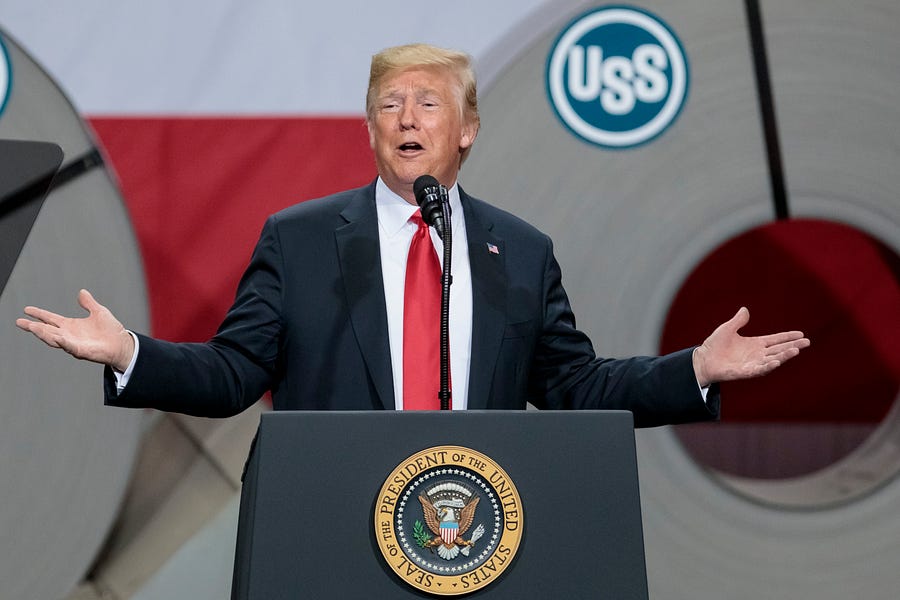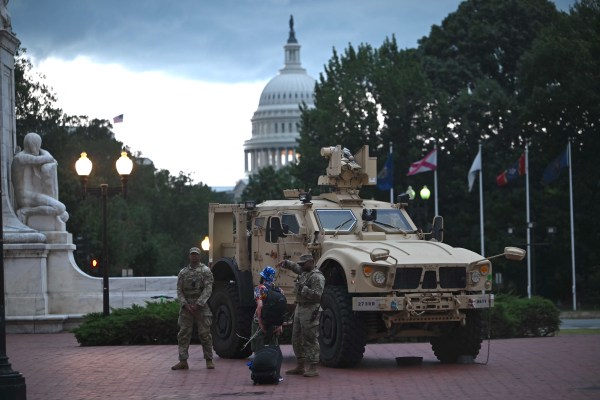An administration that has disregarded the legal limits on the president’s trade authority and rules governing U.S. trade agreements will soon be rewarded with a big election-year win. The House has already approved the United States Mexico Canada Agreement, and the Senate is all but certain to follow—never mind legitimate concerns that it will actually inhibit trade and investment. Whatever the deal’s economic impact, its most important contribution may be what it says about our policymaking system—and the president who broke it.
How did we get here? Trump campaigned on renegotiating NAFTA—“the worst trade deal ever made,” he called it—and in May 2017 he notified Congress of his intent to fulfill this promise. Multiple rounds of negotiations with Mexico and Canada followed, even as Trump frequently threatened to withdraw from NAFTA or impose tariffs—a step he actually took in June 2018, complicating the talks.
Somehow, the parties struck a deal in September 2018 and signed it on November 30, 2018—a few weeks after the House flipped in the midterms. The newly empowered Democrats quickly asserted that the deal wouldn’t work in its present form and started pushing for stricter labor standards and other measures. Between that and the tariffs, many people (including members of Congress) believed that the agreement would be shelved until 2020 or later.
But then U.S. Trade Representative Robert Lighthizer held closed-door negotiations with a “working group” of House Democrats handpicked by Nancy Pelosi. The result? Substantial, unpublished modifications of the deal, covering labor and environmental standards, intellectual property, dispute settlement, and other issues. Those were announced on December 10, 2019, and the deal was signed by the three countries that same day. A whirlwind of activity followed: The amendments were released to the public on December 11; the complete (and lengthy) implementing bill was introduced in Congress two days later; the House Ways and Means Committee reviewed the bill (without changes) on December 17; and the House passed it on December 19 after impeaching the president and right before leaving town for the holidays.
So legislation governing well more than $1 trillion in annual trade went from vapor to almost-law in about a week. The deal maintains many of NAFTA’s core commitments as well as provisions from the jettisoned Trans-Pacific Partnership, but the amendments do contain substantial changes that warrant real discussion and debate. The Cato Institute’s Dan Ikenson called the deal the “Protectionist Love Child of the Labor Left and the Nationalist Right,” pointing to new regulations and mandates on wages and the environment that will actually discourage cross-border trade and investment in the NAFTA region. It’s no coincidence, then, that “USMCA” has taken the “free trade” out of “NAFTA,” or that the most optimistic economic assessment of the new agreement—from the U.S. International Trade Commission—actually projects a small net decrease in U.S. GDP unless you include questionable assumptions about reducing trade uncertainty. Other economic assessments, meanwhile, are even less sanguine.
So, the White House barely consulted Congress, bullied our trading partners into signing a more protectionist agreement, and then kept the text of major, more-protectionist legislative amendments hidden until a few days before Congress adjourned for the year. In a normal time, this process would spell doom for a U.S. trade agreement—in fact, Speaker Pelosi submarined President Bush’s U.S.-Colombia Free Trade Agreement in 2008 for far more minor procedural reasons.
It’s a sign of how times have changed, and how few principled advocates for free trade remain in Congress—or, at least, are willing to defy the president on behalf of those principles. The measure passed passed the House 385-41, the most lopsided House vote in favor of a U.S. trade agreement in decades.
So how did this happen?
Put simply, the elaborate, decades-old system that Congress and the executive branch established to guide U.S. trade policy wasn’t prepared for a President Donald J. Trump.
A brief history lesson: Up until the 1930s, Congress was generally protectionist on trade, but starting with the Reciprocal Tariff Act of 1934 and continuing through the Trade Act of 1974, which established Trade Promotion Authority, the legislative branch delegated to the president wide swaths of the international trade authority granted to it by Article I, Section 8 of the Constitution. In return, Congress maintained certain checks on the president’s new trade powers.
Trade Promotion Authority, for example, represents a “gentleman’s agreement” between the legislative branch and the executive branch—with the former promising the latter “fast track” rules for the requisite congressional approval of a free trade agreement if the president 1) follows a detailed set of congressional “negotiating objectives” for the agreement’s content; and 2) engages in a series of consultations with Congress on that content. Each branch retains its constitutional authority to abandon this gentleman’s agreement, but it was widely assumed that doing so would effectively kill any hope of signing and implementing new FTAs. Thus, while the 15 U.S. trade agreements that preceded the USMCA were hardly perfect, they all removed far more barriers than they imposed, and Congress and the executive generally toed the line when negotiating and considering them.
However, TPA and many of the other statutes that grant the president the power to restrict or liberalize trade rest on three core assumptions that have now proven to be woefully mistaken.
-
Because the president represents the entire country and because trade produces substantial net economic and foreign policy benefits, it was assumed he would be less influenced by protectionism’s concentrated local benefits and thus be the least protectionist person in government.
-
Being an honest public servant, the president would adhere to both the letter and spirit of the new U.S. trade laws—on issues like congressional consultations, trade agreement withdrawal, invoking “national security” or “national emergencies” to impose tariffs, etc.—that gave him his trade powers.
-
If assumptions one or two proved incorrect, Congress would, in bipartisan fashion, vigorously check any presidential abuses of trade power because, even if certain members liked a president’s action, the body as a whole would “jealously guard” its remaining authority under the Constitution.
Due to these three assumptions, U.S. trade law is littered with truck-wide loopholes and dusty old statutes that haven’t been used in decades (if ever)—each of which would allow a more protectionist, less (ahem) principled president to cause all sorts of trade mayhem. But because no president ever actually did that on a clear and consistent basis, Congress did what Congress does best: nothing.
The USMCA, however, shows how Trump has punctured each of these core assumptions. He constantly threatened—and even imposed—alleged “national security” tariffs in an admitted attempt to gain leverage in the negotiations. (The official report on auto tariffs is also still secret.) He also repeatedly claimed he’d withdraw from NAFTA for similar reasons, even though no U.S. law expressly grants him that power. Congress, meanwhile, was kept mostly in the dark during the USMCA negotiations, and only a handful of House Democrats—plus, of course, the AFL-CIO—were involved in the most recent amendments.
What was the result of Trump’s defiling the “gentleman’s agreement” between the two branches and using his “free trade agreement” powers to advance the very protectionism that the system sought to deter? A massive House victory, and a Senate ready to provide the same.
In fact, the USMCA legislation not only fails to check the president’s actions, but actually grants him potentially vast (and certainly ambiguous) new powers over automotive trade, labor enforcement, and the periodic extension or “sunsetting” of the agreement. So much for the third assumption undergirding U.S. trade policy: It’s not that Congress has learned nothing from the last three years of presidential trade adventurism, it’s that its members simply don’t care enough about process, policy, or their constitutional powers to do anything about it.
Democrats ignored the Trump administration’s process crimes and their own recent criticisms because they were able to deliver a gift to their labor union friends by forcing developed country standards (high minimum wages and other measures) on a developing country.
Supposed “free-trade” Republicans, meanwhile, are simply too afraid of the president to challenge him, despite the economic harms and adverse precedent that the USMCA saga creates. The new economic nationalists of the GOP, on the other hand, are cheering this on because … MAGA or something. (So much for their past concerns, and those of many other trade-skeptics, about TPA’s and past FTAs’ alleged attacks on the Constitution, transparency and national sovereignty.)
Top it all off with an impeachment, white-hot partisanship and a U.S. business community that just wants it all to go away, and what do you get? Free-trade advocates Justin Amash and Pat Toomey, alone, yelling “Stop!”
As a result, a law rewiring the NAFTA system and—if Pelosi and the unions get their way—establishing a swampier, more protectionist template for future U.S. trade agreements will sail through Congress. Moreover, other Trump trade deals and tariff actions will avoid even a hint of scrutiny from the branch of government with actual constitutional authority over such policies. The 85-year-old system that was specifically designed to prevent these outcomes will continue to wither away. If the president doesn’t care about the rules, and Congress doesn’t care about the rules (and most of the American public is ignorant or ambivalent about the rules), then, well … so much for the rules.
And, barring a dramatic presidential reversal in 2021, one can expect more of the same—if not worse—in the future.
Scott Lincicome is an international trade attorney, an adjunct scholar at the Cato Institute and a visiting lecturer at Duke University Law School. The views expressed herein are his own and do not necessarily reflect those of his employer.
Photograph of Donald Trump at U.S. Steel’s Granite City Works plant in Granite City, Illinois by Whitney Curtis/Getty Images.







Please note that we at The Dispatch hold ourselves, our work, and our commenters to a higher standard than other places on the internet. We welcome comments that foster genuine debate or discussion—including comments critical of us or our work—but responses that include ad hominem attacks on fellow Dispatch members or are intended to stoke fear and anger may be moderated.
With your membership, you only have the ability to comment on The Morning Dispatch articles. Consider upgrading to join the conversation everywhere.